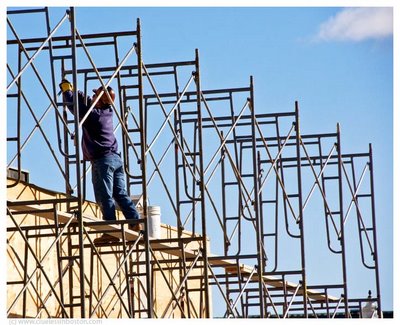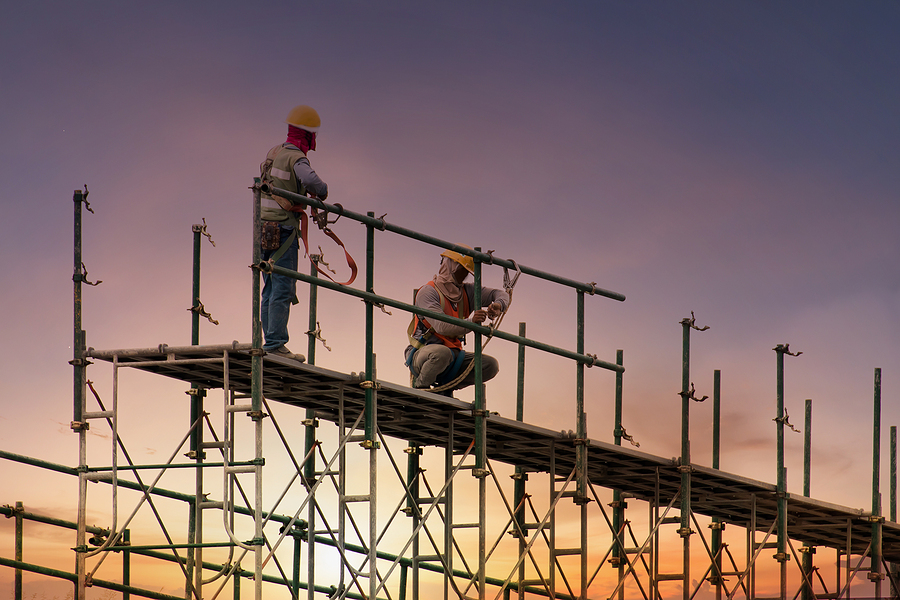Safe and Durable Scaffolding Guildford for Your Upcoming Construction Work
Safe and Durable Scaffolding Guildford for Your Upcoming Construction Work
Blog Article
Checking Out the Various Sorts Of Scaffolding Made Use Of in Building Tasks
The building and construction market counts heavily on various types of scaffolding to meet certain job requirements, each offering unique benefits and applications. Typical frame scaffolding gives a durable foundation for basic jobs, while suspended scaffolding is important for job on high-rise structures.

Traditional Structure Scaffolding
Traditional structure scaffolding is among one of the most extensively utilized methods in the building sector because of its toughness and adaptability. This system is composed of horizontal and vertical structures that are set up to create a stable system for employees and products. The major parts include upright blog posts, horizontal journals, and angled braces, which together give a strong framework that can sustain considerable loads.
One of the crucial benefits of typical structure scaffolding is its flexibility to different building tasks, varying from domestic buildings to big commercial frameworks. The modular style permits very easy assembly and disassembly, making it efficient for both short-term and lasting tasks. In addition, the system can be tailored in height and width, suiting different structure layouts and website conditions.
Safety and security is critical in scaffolding applications, and typical frame systems are furnished with guardrails and toe boards to stop falls and make certain employee protection. Normal inspections and adherence to security guidelines are crucial in keeping the honesty of the scaffold (Scaffolding). In general, conventional frame scaffolding stays a fundamental choice in the building sector, giving a reputable platform for labor and enhancing total task performance

Suspended Scaffolding
Suspended scaffolding provides a distinct service for building projects that require access to raised surfaces, especially in circumstances where conventional framework scaffolding may be not practical. This kind of scaffolding is commonly put on hold from the roofing system or top levels of a structure, making use of a system of sheaves, systems, and ropes to develop a working room that can be gotten used to various heights.
Among the key advantages of suspended scaffolding is its flexibility. It can be quickly rearranged or lowered to fit adjustments in building requirements, making it suitable for jobs such as window installment, frontage job, and maintenance on skyscraper structures. Additionally, the very little impact of suspended scaffolding enables far better use ground area in city environments, where room is frequently minimal.
Security is a critical consideration in the use of suspended scaffolding. In general, suspended scaffolding supplies a effective and efficient option for accessing hard-to-reach locations in different building situations, improving both efficiency and security on site.
System Scaffolding
System scaffolding, typically considered as a contemporary service in the scaffolding industry, contains pre-engineered elements that can be rapidly put together and adapted for numerous building and construction jobs. Scaffolding. This type of scaffolding is characterized by its modular design, which permits for convenience and effectiveness on task sites, suiting architectural requirements and various elevations
Commonly made from high-strength steel or light weight aluminum, system scaffolding provides enhanced resilience and stability. The parts consist of vertical blog posts, horizontal ledgers, and angled braces, which adjoin securely, making sure a robust structure. The style frequently integrates standard fittings, streamlining setting up and disassembly processes, therefore minimizing labor time and costs.

Rolling Scaffolding
Moving scaffolding is a versatile option to conventional set scaffolding, made for wheelchair and ease of usage on construction websites. This type of scaffolding is composed of a system supported by frames with wheels, enabling workers to conveniently transfer it as required. The mobility feature considerably improves performance, as it reduces downtime connected with setting up and dismantling repaired scaffolding.
Commonly built from light-weight products such as aluminum or steel, rolling scaffolding offers a strong yet portable service for jobs needing frequent repositioning - Scaffolding. It is specifically helpful in tasks such as painting, drywall installment, and electrical work, where access to various elevations and areas is required
Security is critical in rolling scaffolding style, with features such as securing Get More Information wheels to avoid unplanned activity when being used, and guardrails to shield workers from falls. In addition, numerous designs are flexible in height, fitting different task needs.
Cantilever Scaffolding

The design of cantilever scaffolding usually involves utilizing braces or arms secured to a building or structure, making it possible for the platform to expand outward safely. Safety is extremely important; thus, these scaffolds must be engineered to hold up against different tons and environmental conditions. Routine examination and upkeep are vital to ensure architectural integrity and worker security.
Cantilever scaffolding is favored for its convenience and effective use room, making it a popular selection in city settings where area restrictions are common. Moreover, it facilitates much easier accessibility to this website high elevations, inevitably adding to the overall performance of building projects. Just like all scaffolding types, appropriate training and adherence to security requirements are crucial for workers making use of cantilever scaffolding.
Final Thought
Conventional structure scaffolding supplies security, while put on hold scaffolding supplies adaptability for elevated tasks. System scaffolding facilitates quick setting up, and rolling scaffolding improves wheelchair for differing work environments.
Traditional frame scaffolding offers a tough structure for basic jobs, while suspended scaffolding is essential for work on high-rise structures.Moving scaffolding is a flexible option to conventional fixed scaffolding, made for mobility and ease of use on building and construction sites. As with all scaffolding kinds, proper training and adherence to safety and security criteria are crucial for workers using cantilever scaffolding.
Traditional framework scaffolding supplies stability, while put on hold scaffolding provides flexibility for elevated see post jobs. System scaffolding facilitates quick assembly, and rolling scaffolding enhances mobility for differing job environments.
Report this page